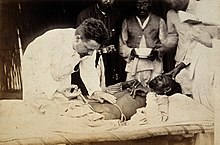第三次鼠疫大流行


第三次鼠疫大流行(英語:Third plague pandemic),是人类历史上鼠疫的第三次大流行,起始于1855年清朝咸丰年间的云南,直到20世纪中叶逐渐结束[1][2][3][4][5]。此次鼠疫为腺鼠疫,于1890年代传播到香港、广州等地,此后逐渐传播到世界上至少60余个国家和地区[5],造成疫情大流行,导致全球约1200万至1500万人死亡,是人类历史上致死人数最多的流行病之一[1][3][4][6][7][8]。
此次鼠疫大流行中,印度于1898年-1908年间即有约600万人死亡,其它较为重大的疫情包括香港鼠疫、东北大鼠疫等[3][7][9]。1894年,法国科学家亚历山大·耶尔辛在香港首次成功分离出鼠疫杆菌(后人称“耶尔辛氏菌”)[6][9][10];1897年,法国犹太裔微生物学家沃尔德玛·哈夫金发明了人类首剂鼠疫疫苗[11][12][13]。
疫情历史
起源
人类历史上第一次鼠疫大流行(开端为查士丁尼瘟疫)、第二次鼠疫大流行(开端为黑死病)曾造成欧洲人口锐减[2][14]。1855年,清朝云南地区爆发鼠疫、成为第三次鼠疫大流行的源头,而此前从1772年起,该地区已出现多次小规模疫情[1][2][3][5][6]。
中国大陆及香港疫情
|
参见:云南回变 |
1856年-1873年间,云南回变,但被清军镇压,与此同时鼠疫开始流行[15][16]。1882年,鼠疫传播到广西北海,由前往云南地区平叛的清军带回[15][16]。
1894年,鼠疫传播到了广州和香港等地,导致大流行、造成了香港鼠疫[7]。1894年3月至6月之间,据不完全统计,广州有约4万人死亡[17]。1894年5月,香港成为疫区,而据英屬香港政府、《香港历史图说》等记载,香港地区(香港島、九龍)死亡至少2500余人[17]。
此后,从19世纪末到中华人民共和国成立,中国大陆先后发生过六次较大的鼠疫疫情,波及20多个省(区),发病人数约115万、死亡约100万人[1]。其中较为重大的疫情包括东北大鼠疫、山西鼠疫、察北鼠疫等,在东三省一度出现“全村绝户,重病必死”的情况[2][3]。清政府曾成立“京师防疫事务局”以应对东三省的鼠疫蔓延,并在山海关设立了检验所[3]。
其它地区疫情
此后疫情蔓延到了世界其它地区,鼠疫通过蒸汽商船由海上传播到日本、新加坡、台湾以及印度等地,此后又传播到里约热内卢、夏威夷、旧金山、悉尼、开普敦等地[4][6][7]。全球至少五大洲、60多个国家和地区都爆发了鼠疫疫情,其中印度于1898年-1908年间即有约600万人因此死亡[5][7],其它发生疫情的地区包括:
死亡人数
据各方估计,此次疫情在全球范围内共造成1200万-1500万人死亡,大多数集中在印度、中国以及印度尼西亚的人口密集地区,是历史上致死人数最多的流行病之一[1][3][4][6][7][8][25]。此次疫情直到二十世纪中叶(1959年左右)才结束, 依据世界卫生组织,此后世界范围内每年因鼠疫死亡人数最低降至约200人[7][25]。
科学研究

1894年,法国科学家亚历山大·耶尔辛前往香港调查当地鼠疫疫情,并首次成功分离出鼠疫杆菌(后人因此称鼠疫杆菌为“耶尔辛氏菌”)[6][9][10]。他的发现及时促成了现代的鼠疫预防和治疗手段,譬如杀虫剂、抗生素以及鼠疫疫苗等[9][10]。
1897年,法国犹太裔微生物学家沃尔德玛·哈夫金在印度孟买省发明了首剂鼠疫疫苗,随即在当地开始了大规模接种[11][12][13]。
1898年,法国研究人员保尔–路易·西蒙德展示了跳蚤是如何作为鼠疫传播的载体[26][27]。鼠疫常由携带鼠疫杆菌的跳蚤叮咬引起,而跳蚤来自于被感染的宿主(常为黑鼠)[27][28]。
1910年,东北大鼠疫期间,知名医学家伍连德在防疫过程中扮演了重要角色,发现了旱獭在传播鼠疫中的作用,确认了肺鼠疫由“呼吸”和“飞沫”传播,并采取了多种防治措施在数月之内控制住了疫情[1]。1911年4月,清政府曾在沈阳举办“万国鼠疫研究会”,有11国参与、由伍连德主持,此后还在哈尔滨建立了“鼠疫研究所”、伍连德任所长[3][29]。
参见
参考资料
- ^ 1.0 1.1 1.2 1.3 1.4 1.5 赵欣. 历史上那些骇人的传染病[疫情科普系列之九]. 中国科学院微生物研究所. 2020-02. (原始内容存档于2021-04-20) (中文).
- ^ 2.0 2.1 2.2 2.3 小小老鼠,酿成大疫 鼠疫究竟是什么?. 中国疾病预防控制中心. 2017-10-31. (原始内容存档于2021-01-28) (中文).
- ^ 3.0 3.1 3.2 3.3 3.4 3.5 3.6 3.7 鼠疫血清的背后,躺着一亿八千七百万具尸体. 中国网. 2020-07-11. (原始内容存档于2021-02-01) (中文).
- ^ 4.0 4.1 4.2 4.3 Josh Sanburn. Top 10 Terrible Epidemics. 《时代周刊》(Time). 2010-10-26. ISSN 0040-781X. (原始内容存档于2021-02-14) (美国英语).
- ^ 5.0 5.1 5.2 5.3 Shi, Liyuan; Yang, Guirong; Zhang, Zhikai; Xia, Lianxu; Liang, Ying; Tan, Hongli; He, Jinrong; Xu, Jianguo; Song, Zhizhong. Reemergence of human plague in Yunnan, China in 2016. PLoS ONE. 2018-06-13, 13 (6). ISSN 1932-6203. PMC 5999221
 . PMID 29897940. doi:10.1371/journal.pone.0198067.
. PMID 29897940. doi:10.1371/journal.pone.0198067.
- ^ 6.0 6.1 6.2 6.3 6.4 6.5 Bramanti, Barbara; Dean, Katharine R.; Walløe, Lars; Chr. Stenseth, Nils. The Third Plague Pandemic in Europe. Proceedings of the Royal Society B: Biological Sciences. 2019-04-24, 286 (1901). ISSN 0962-8452. PMC 6501942
 . PMID 30991930. doi:10.1098/rspb.2018.2429. (原始内容存档于2020-03-25).
. PMID 30991930. doi:10.1098/rspb.2018.2429. (原始内容存档于2020-03-25).
- ^ 7.0 7.1 7.2 7.3 7.4 7.5 7.6 WHO Report on Global Surveillance of Epidemic-prone Infectious Diseases (PDF). 世界卫生组织(WHO). (原始内容 (PDF)存档于2021-03-19) (英语).
- ^ 8.0 8.1 Myron Echenberg. Pestis Redux: The Initial Years of the Third Bubonic Plague Pandemic, 1894-1901 (PDF). Journal of World History. 2002, 13 (2): 429-449.
- ^ 9.0 9.1 9.2 9.3 Butler, T. Plague history: Yersin's discovery of the causative bacterium in 1894 enabled, in the subsequent century, scientific progress in understanding the disease and the development of treatments and vaccines. Clinical Microbiology and Infection: The Official Publication of the European Society of Clinical Microbiology and Infectious Diseases. 2014-03, 20 (3): 202–209. ISSN 1469-0691. PMID 24438235. doi:10.1111/1469-0691.12540. (原始内容存档于2021-02-04).
- ^ 10.0 10.1 10.2 鐘金湯; 劉仲康. 耶爾辛——鼠疫菌的發現者-科技大觀園. 科技大觀園. 2004-07-06. (原始内容存档于2021-02-01) (中文(臺灣)).
- ^ 11.0 11.1 Joel Gunter, Vikas Pandey. Waldemar Haffkine: The vaccine pioneer the world forgot. BBC News. 2020-12-11. (原始内容存档于2021-04-10) (英国英语).
- ^ 12.0 12.1 Joel Gunter; Vikas Pandey. 沃尔德玛·哈夫金:被世界遗忘的疫苗先驱. 英国广播公司(BBC). 中国医疗. 2020-12-11. (原始内容存档于2021-04-16) (中文).
- ^ 13.0 13.1 WALDEMAR MORDECAI HAFFKINE. Haffkine Institute. (原始内容存档于2015-09-24) (英语).
- ^ 教科文组织:黑死病在丝绸之路上的传播给人们带来何种启示?. 联合国. 2020-04-01 [2020-12-07]. (原始内容存档于2021-04-08) (中文).
- ^ 15.0 15.1 赖文,李永宸. 粮食、习俗、卫生与十九世纪的岭南瘟疫. 《中国中医基础医学杂志》. 2004, (10). (原始内容存档于2021-02-01).
- ^ 16.0 16.1 曹树基,李玉尚. 历史时期中国的鼠疫自然疫源地 (PDF). 上海交通大学 (中文).
- ^ 17.0 17.1 姬凌辉. 1894年香港鼠疫中的“太平山事件”. 澎湃新闻. 2016-05-23. (原始内容存档于2021-01-31) (中文).
- ^ "Plague Hospital in Porto - 1899". Apollo - University of Cambridge Repository (Institut Pasteur(巴斯德研究院)). 2018-11-08. doi:10.17863/CAM.32180. (原始内容存档于2021-02-06) (英语).
- ^ Honolulu's Battle with Bubonic Plague. All about Hawaii: The Recognized Book of Authentic Information on Hawaii, Combined with Thrum's Hawaiian Annual and Standard Guide. Honolulu Star-Bulletin. 1900: 97 [2020-12-28]. (原始内容存档于2020-08-19) (英语).
- ^ KEVIN R. BAILEY. PLAGUE IN PARADISE: A STUDY OF PLAGUE ON HAWAIIAN SUGARCANE PLANTATIONS (PDF). 俄勒冈大学 (University of Oregon). 2007-06. (原始内容存档 (PDF)于2020-08-09) (英语).
- ^ Bubonic plague. 澳大利亚国立博物馆 (National Museum of Australia). (原始内容存档于2019-05-27) (英语).
- ^ Journal of the American Medical Association 36. American Medical Association. 1901: 1042. (原始内容存档于2016-05-07) (英语).
- ^ Rats 'wrongly blamed' for 1900 Glasgow plague outbreak. BBC News. 2019-01-02. (原始内容存档于2021-02-20) (英国英语).
- ^ R. POLLITZER. PLAGUE STUDIES 1. A Summary of the History and a Survey of the Present Distribution of the Disease (PDF). Bull. World Hlth Org. 1951, (4): 475-533.
- ^ 25.0 25.1 John Frith. The History of Plague – Part 1. The Three Great Pandemics. Journal of Military and Veterans' Health. 2012-04. (原始内容存档于2019-10-02) (英语).
- ^ Mollaret, H. H. [The discovery by Paul-Louis Simond of the role of the flea in the transmission of the plague]. Bulletin De La Societe De Pathologie Exotique (1990). 1999-12, 92 (5 Pt 2): 383–387. ISSN 0037-9085. PMID 11000944.
- ^ 27.0 27.1 Simond, M.; Godley, M. L.; Mouriquand, P. D. Paul-Louis Simond and his discovery of plague transmission by rat fleas: a centenary. Journal of the Royal Society of Medicine. 1998-02, 91 (2): 101–104. ISSN 0141-0768. PMC 1296502
 . PMID 9602755. doi:10.1177/014107689809100219. (原始内容存档于2021-01-31).
. PMID 9602755. doi:10.1177/014107689809100219. (原始内容存档于2021-01-31).
- ^ Simond, M.; Godley, M. L.; Mouriquand, P. D. Paul-Louis Simond and his discovery of plague transmission by rat fleas: a centenary. Journal of the Royal Society of Medicine. 1998-02, 91 (2): 101–104. ISSN 0141-0768. PMC 1296502
 . PMID 9602755. doi:10.1177/014107689809100219. (原始内容存档于2021-01-31).
. PMID 9602755. doi:10.1177/014107689809100219. (原始内容存档于2021-01-31).
- ^ 于永敏; 刘进; 王忠云. 沈阳万国鼠疫研究会始末. 中国知网. 中国科技史料. 1995年. (原始内容存档于2021-02-04).
| ||||||||||||||||||||||||||||||||||||||||||||||
Text is available under the CC BY-SA 4.0 license; additional terms may apply.
Images, videos and audio are available under their respective licenses.
